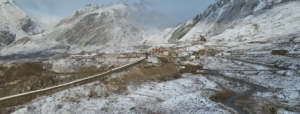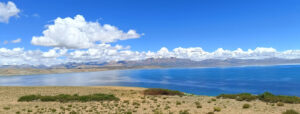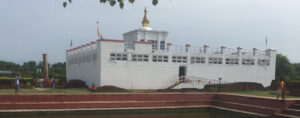Many adventure lovers dream of trekking to Everest Base Camp to see the Himalayas. Proper gear and supplies are necessary to make this ultimate adventure comfortable and secure. This Everest Base Camp trek packing list will help you pack everything you require, from clothing and footwear to first aid and add-ons.
The EBC trekking gear is important for staying comfortable and safe. The Everest Base Camp trek lets one see the world’s highest mountain up close. From Kathmandu’s busy streets to the Khumbu area’s peaceful trails, every step leads you towards the giant peak of Mount Everest. Along the way, you’ll pass friendly Sherpa villages, see colorful prayer flags, and enjoy breathtaking views of snow-covered peaks. Whether you’re an experienced trekker or new to hiking, the Everest Base Camp trek promises an unforgettable experience.
Comprehensive Everest Base Camp Trek Packing Checklist
Preparing for the Everest Base Camp trek requires careful planning and the right gear to ensure a safe, comfortable, and enjoyable journey. The challenging terrain, changing weather conditions, and high altitudes demand specific clothing, equipment, and supplies. This comprehensive packing checklist covers everything from essential clothing and footwear to personal care items and eco-friendly trekking practices, helping you be fully equipped for the adventure of a lifetime in the Himalayas.
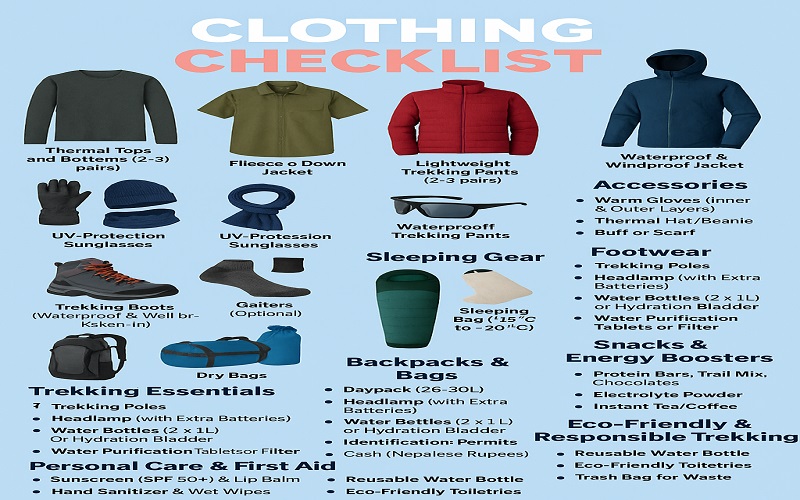
Clothing
- Thermal Tops and Bottoms (2-3 pairs)
- Quick-Dry Trekking Shirts (3-4)
- Fleece or Down Jacket
- Lightweight Trekking Pants (2-3 pairs)
- Waterproof & Windproof Jacket
- Waterproof Trekking Pants
Accessories
- Warm Gloves (Inner & Outer Layers)
- Thermal Hat/Beanie
- Buff or Scarf
- UV-Protection Sunglasses
Footwear
- Trekking Boots (Waterproof & Well Broken-in)
- Camp Shoes or Sandals
- Woolen Socks (4-5 pairs)
- Gaiters (Optional)
Sleeping Gear
- Sleeping Bag (-15°C to -20°C)
- Sleeping Bag Liner
Backpacks & Bags
- Daypack (25- 30L)
- Duffel Bag (70- 90L)
- Dry Bags
Trekking Essentials
- Trekking Poles
- Headlamp (with Extra Batteries)
- Water Bottles (2 x 1L) or Hydration Bladder
- Water Purification Tablets or Filter
Personal Care & First Aid
- Sunscreen (SPF 50+) & Lip Balm
- Hand Sanitizer & Wet Wipes
- Quick-Dry Towel
- Basic Toiletries (Toothbrush, Toothpaste, Biodegradable Soap)
- Tissue/Toilet Paper
- Altitude Sickness Medication (Diamox)
- Painkillers & Anti-Inflammatory Tablets
- Band-Aids & Blister Patches
- Rehydration Salts & Energy Gels
Snacks & Energy Boosters
- Protein Bars, Trail Mix, Chocolates
- Electrolyte Powder
- Instant Tea/Coffee
Electronics & Documentation
- Camera/GoPro with Extra Batteries
- Power Bank & Solar Charger
- Notebook & Pen
- Identification & Permits
- Cash (Nepalese Rupees)
Eco-Friendly & Responsible Trekking
- Reusable Water Bottle
- Eco-Friendly Toiletries
- Trash Bag for Waste
Essential Clothing For the Everest Base Camp Trek
Wear layers of clothing to prepare for the changing weather when gearing up for the Everest Base Camp trek. The following is a general guide to what to pack for the Everest Base Camp:
Base Layers (Moisture-Wicking & Warmth)
1. Thermal Tops and Bottoms (2-3 pairs): These will keep you warm and also draw moisture away from your skin, which is important to stay dry and comfortable during the trek.
2. Quick-Dry trekking Shirts (3-4): Trekking shirts that are lightweight and breathable ensure that you stay cool even on those long hiking days. Plus, the shirts dry quickly, so you don’t stay wet in case you sweat or get soaked in the rain.
Mid Layers (Insulation & Warmth)
1. Fleece or Down Jacket: These insulating jackets provide the warmth you need on the colder part of the trek, especially when you are up at high elevations or at nighttime when temperatures drop.
2. Lightweight Trekking Pants (2-3 pairs): These are durable yet comfy pants capable of withstanding lengthy treks and keeping you relaxed on the trails.
Outer Layers (Protection)
1. Waterproof & Windproof Jacket: Mountain weather is not predictable, and it changes instantly, so a waterproof and windproof jacket is needed to protect you from rain, snow, and wind.
2. Waterproof Trekking Pants: Waterproof trekking pants are dry and warm in rainy or snowy conditions and prevent you from getting wet while on the trail.
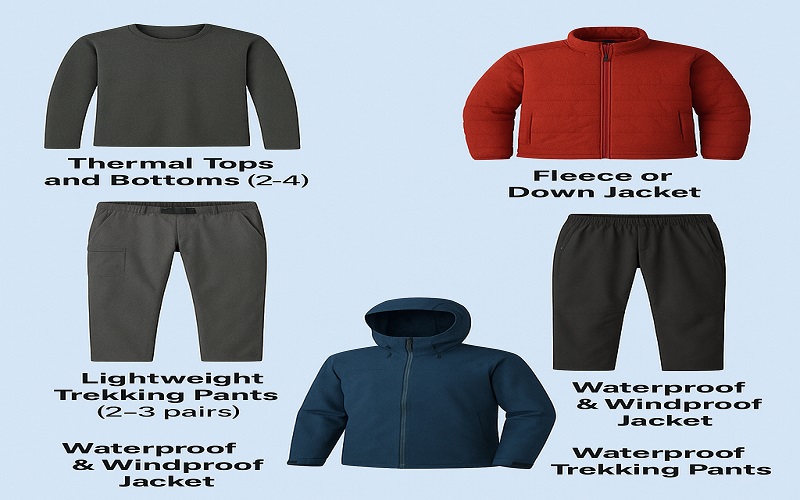
Accessories
1. Warm Gloves (Inner & Outer Layers): One pair of gloves will keep your hands warm when it is cold. And the outer layers will provide you with more protection.
2. Thermal Hat/Beanie: A beanie or warm hat will help retain the heat and keep you warm, especially on chilly mornings or in high-altitude areas.
3. Buff or Scarf: A Buff or Scarf is fantastic and multi-use. It will keep your face and neck from becoming dusty, windy, or chilly, so you can keep hiking happily.
4. UV-Protection Sunglasses: The sun’s rays from the mountain are intense, and you will need sunglasses to protect your eyes against damaging UV radiation and help improve visibility on sunny days. These accessories and layers make up your one Everest Base Camp trek packing list, keeping you dry, warm, and protected throughout your journey. With these items on the list, you will be well-prepared for the changing weather conditions of the Everest Base Camp trek.
Footwear
A good pair of shoes is crucial for an enjoyable hiking experience, especially considering the Everest Base Camp trek’s difficulty. Proper footwear can make a significant difference in navigating the challenging terrain, ensuring comfort and safety throughout your journey.
1. Trekking Boots: Get your boots well broken in before the trek to avoid blisters. Waterproof boots will keep your feet dry, especially in rain or snow.
2. Camp Shoes or Sandals: They are great for relaxing at the lodges after a day’s hike. They allow your feet to breathe and relax.
3. Woolen Socks (4-5 pairs): Woolen socks keep your feet dry and warm as they soak up moisture. Bring enough pairs so that you don’t run out.
4. Gaiters: Gaiters are not necessary but are handy for snowy or dirty trails. They keep your lower legs and boots free from snow, mud, or dust.
These are your EBC trek gear essentials for your feet. They ensure your feet are comfortable, dry, and protected during the adventure.
Sleeping Gear
Good sleeping gear is needed to sleep well, especially at altitudes where the temperature falls sharply.
1. Sleeping Bag (-15°C to -20°C): You need a good sleeping bag to keep you warm on cold Himalayan nights. If not available, rent a good-quality sleeping bag in Kathmandu. If you have difficulties choosing or renting the best sleeping bag, Asian Heritage will help you hire and buy the best quality for the Everest trek.
2. Sleeping Bag Liner: A thin liner that adds warmth and keeps the sleeping bag fresh and clean throughout the trek.
These will make you warm and cozy on your trip, and you can add them to your Everest Base Camp trek packing list.
Backpacks & Bags
Light packing is the key to an enjoyable and trouble-free trek. Porter will carry most of your loads, and you will be left with only that day’s necessities. A well-planned Everest Base Camp trekking packing list ensures you take what you require, keeping your trip simpler and your pack lighter.
1. Daypack (25- 30L): This is a light, compact backpack for carrying daily supplies like water, snacks, extra clothes, and other essentials. It must have padded straps and a waist belt for extra comfort.
2. Duffel Bag (70- 90L): A large, tough bag to carry most of your trekking gear, which will be portered. It must be spacious, tough, and easy to pack.
3. Dry Bags: Best applied for the protection of valuables, electronics, and important documents from rain, snow, or spills.
Trekking Essentials
Proper gear can make your journey much more comfortable and safe. These trekking essentials are a necessity for your comfort and safety during the trip.
1. Trekking Poles: Offer support and take the pressure off your joints, particularly on uneven or rocky surfaces.
2. Headlamp: For early morning departures or late evening walks. Be sure to bring spares.
3. Water Bottles (2 x 1L) or Hydration Bladder: Dehydration is important to avoid. Two bottles or a hydration bladder are convenient and ensure that they can be used with boiling water when required.
4. Water Purification Tablets or Filter: It is vital to have clean drinking water handy at all times on the trek.
5. Map & Compass/GPS: Not required, but these will help in navigation, especially if you plan to go off the beaten path.
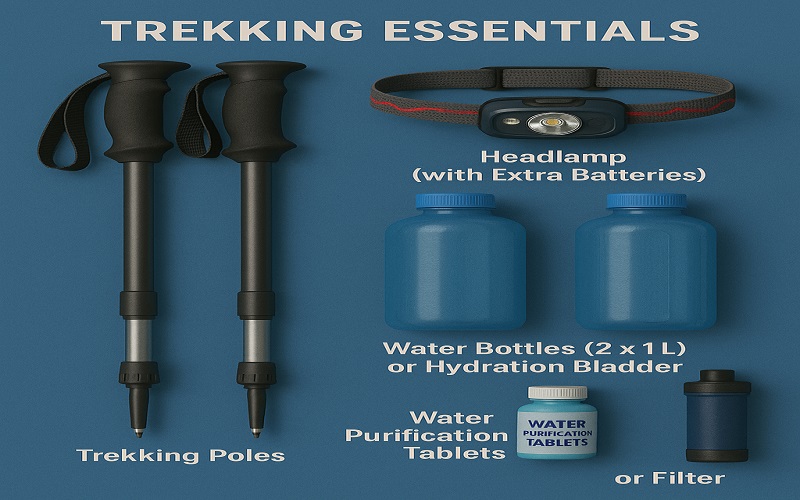
When deciding what to pack for Everest Base Camp, these are some of the most critical things you’ll need to bring. Having the right gear makes for a comfortable, safe, and enjoyable trek.
Personal Care & First Aid
Hygiene and health are crucial, especially when trekking in remote areas like the Everest Base Camp. Keeping the necessary personal care products with you will keep you clean and safe throughout your trek.
1. Sunscreen (SPF 50+) & Lip Balm: Protect your skin and lips from the strong UV sunbeams, especially at higher altitudes where sunlight is stronger.
2. Hand Sanitizer & Wet Wipes: These will provide on-the-go cleanliness, as water might not be easily accessible.
3. Quick-Dry Towel: Light, compact, and perfect for drying off after a tough day.
4. Toiletries Minimum: Do not forget the minimum essentials like a toothbrush, toothpaste, and biodegradable soap to wash.
5. Tissue/Toilet Paper: Not every lodge will offer toilet paper, so it is a good idea to bring your own.
First Aid Kit:
1. Altitude Sickness Medication (Diamox): It’s essential to consult with a doctor before using this, as it helps prevent altitude sickness, a common concern at high altitudes.
2. Painkillers & Anti-Inflammatory Tablets: Handy for dealing with headaches, muscle pain, or any discomfort during the trek.
3. Band-Aids & Blister Patches: These are key for treating minor injuries and preventing blisters, which can easily become a nuisance on long treks.
4. Rehydration Salts & Energy Gels: Help replenish electrolytes and give you an energy boost during the trek, especially when you’re feeling fatigued.
When thinking about what to pack for Everest Base Camp, these essentials are some of the key items you’ll want to include. Packing the right gear ensures a smooth, safe, and enjoyable trek, no matter the challenges you face.
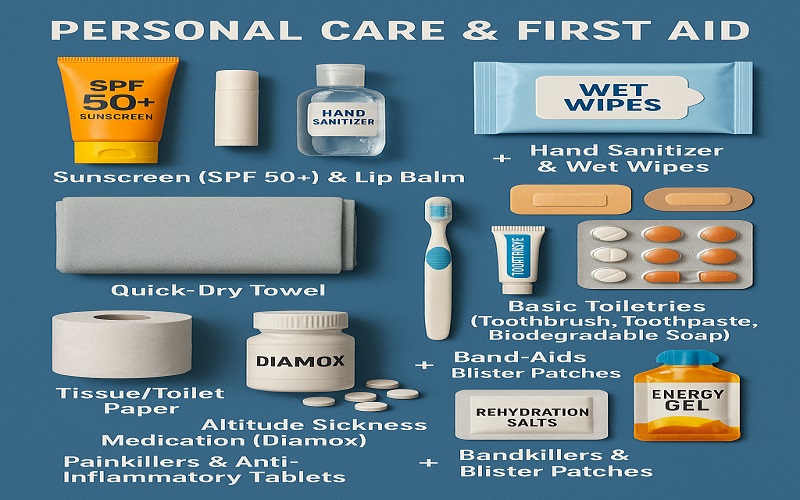
Snacks & Energy Boosters
Though not part of the necessary EBC trek equipment, carrying proper snacks and energy boosters along with you will help keep you energized throughout your trek. These light yet high-energy foods will sustain you through long walking hours, especially at higher altitudes.
1. Protein Bars, Trail Mix, Chocolates: Easily carried snacks that provide an instant boost of energy while on the trek.
2. Electrolyte Powder: This keeps you hydrated and your electrolytes in balance so you can keep going.
3. Instant Tea/Coffee: A warm and comforting treat during your breaks, refreshing and revitalizing you.
These snacks are an important addition to your overall Everest Base Camp trek packing list, ensuring you’re ready to tackle the challenge of the trek while staying energized and hydrated.
Miscellaneous
While not essential, these items can make your Everest Base Camp trek more comfortable and enjoyable. They will help you capture memories, stay charged, and record your journey.
- Camera/GoPro with Extra Batteries
Capture the beautiful Himalayan landscapes and special moments along the trail.
- Power Bank and Solar Charger
Electricity is limited at higher altitudes. Bring backup power to keep your devices charged.
- Notebook and Pen
Write about your trekking experiences, note important details, or sketch the amazing scenery.
4. Cash (Nepalese Rupees)
ATMs are rare, and most places do not accept cards. Carry enough cash for meals, lodging, and emergencies.
Final Packing Tips
Packing wisely for the Everest Base Camp trek can make a huge difference in your comfort and overall experience. Here are some key tips to follow:
1. Pack Light but Smart: Carry only the essentials to keep your backpack manageable. Overpacking can make trekking harder, while underpacking may leave you unprepared. Choose lightweight, multipurpose gear.
2. Break in Your Trekking Boots: New boots can cause painful blisters. Wear them on short hikes before your trek to ensure they are comfortable and fit well.
3. Check the Weather Forecast: The Himalayan weather can be unpredictable. Knowing the conditions beforehand helps you pack the right clothing and gear for a safe journey.
Weather & Seasonal Packing Tips
The weather on the Everest Base Camp trek can vary significantly depending on the season. Understanding how the Everest Base Camp Trek Packing List changes based on the season will help you stay comfortable and prepared throughout the trek. Whether you’re trekking during the pre-monsoon, monsoon, or winter months, each season brings its own set of challenges. Here’s a guide to help you pack accordingly for each season, ensuring you’re ready for anything the weather throws your way.
1. Pre-Monsoon (March-May): Mild weather; pack light layers with a warm jacket for chilly nights.
2. Post-Monsoon (September-November): Ideal trekking conditions; pack breathable layers and some warmth for evenings.
3. Winter (Dec- Feb): Cold temperatures; pack extra warm layers, thermals, and heavy-duty winter gear.
4. Monsoon (Jun- Aug): Rainy season; bring waterproof gear, quick-dry clothing, and extra socks to stay dry.
Renting vs. Buying Gear for the Everest Base Camp Trek
When preparing for the Everest Base Camp trek, you’ll need to decide whether to rent or buy certain trekking gear.
1. Where to Rent Trekking Gear in Kathmandu: Kathmandu has numerous shops offering rentals for gear like sleeping bags, jackets, and trekking poles. The Thamel area is especially popular for gear rental.
2. What’s better to rent vs buy: Renting is ideal for items you’ll use infrequently, like high-altitude sleeping bags and jackets. Buying is better for essential items like trekking boots and backpacks, which need to fit well and withstand wear.
3. Cost-Effective Packing Strategies: Renting items you won’t use often helps save money, but investing in quality gear for comfort and safety is a wise choice for frequent trekkers.
Sustainable & Eco-Friendly Packing
As trekkers, it’s our responsibility to protect the pristine beauty of the Everest region. Adopting eco-friendly practices while packing and trekking is crucial to minimizing our environmental footprint. By reducing plastic waste, we can help preserve stunning landscapes for future generations. Here are some tips on how to pack sustainably and responsibly during your Everest Base Camp trek:
1. Avoiding Plastic Waste: Bring reusable water bottles and eco-friendly toiletries to cut down on single-use plastic.
2. Responsible Trekking: Follow the Leave No Trace principles, ensuring that no waste is left behind during your trek.
3. Where to Refill Water Safely: Use water purification methods or refill at safe stations to avoid purchasing plastic bottles.
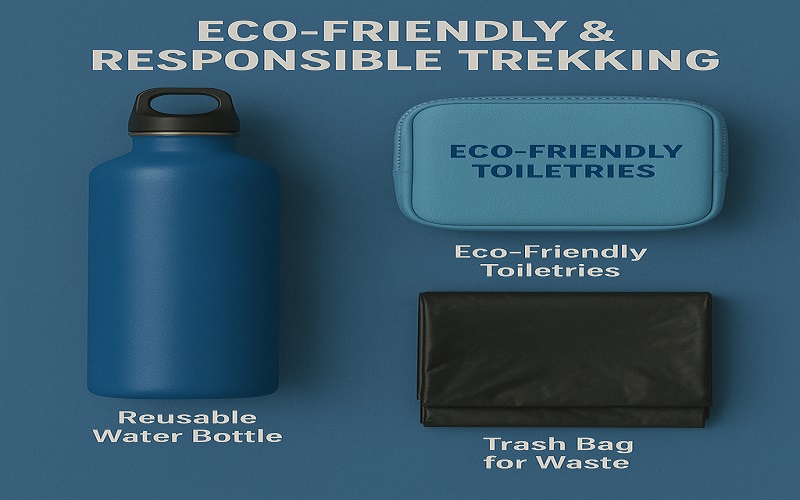
Packing for Different Altitudes
1. Gear for Lower Elevations (Lukla to Namche): Light layers, breathable clothing, and comfortable shoes for warmer conditions.
2. Extra Warm Clothing for Higher Altitudes (Dingboche to EBC): As you ascend, temperatures drop, so bring heavier layers, down jackets, and thermals.
3. Acclimatization Tips: Take it slow, stay hydrated, and rest to prevent altitude sickness on your trek.
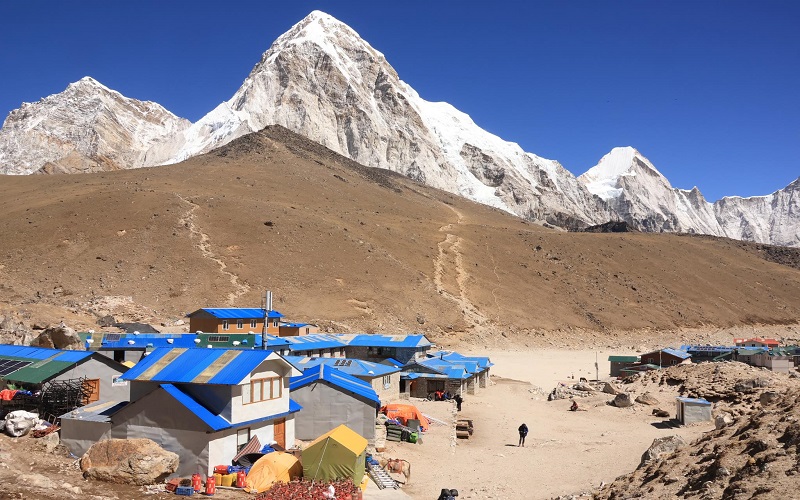
This Everest Base Camp trek packing list is designed to help you choose the right gear for your adventure. Whether you plan to rent or buy equipment in Kathmandu, this guide will set you on the right path. If you have any questions about packing, need trusted gear rental suggestions, or want personalized help with your trekking plan, feel free to reach out. We’re here to make your journey easy, enjoyable, and worry-free!
Let our expert team at Asian Heritage Treks and Travel take care of everything — from guided tours to personalized packing tips and travel arrangements.
Plan My Everest Trip




